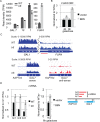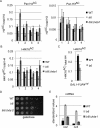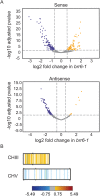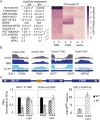Brr6 plays a role in gene recruitment and transcriptional regulation at the nuclear envelope
- PMID: 30133335
- PMCID: PMC6254580
- DOI: 10.1091/mbc.E18-04-0258
Brr6 plays a role in gene recruitment and transcriptional regulation at the nuclear envelope
Abstract
Correlation between transcriptional regulation and positioning of genes at the nuclear envelope is well established in eukaryotes, but the mechanisms involved are not well understood. We show that brr6-1, a mutant of the essential yeast envelope transmembrane protein Brr6p, impairs normal positioning and expression of the PAB1 and FUR4- GAL1,10,7 loci. Similarly, expression of a dominant negative nucleoplasmic Brr6 fragment in wild-type cells reproduced many of the brr6-1 effects. Histone chromatin immunoprecipitation (ChIP) experiments showed decreased acetylation at the key histone H4K16 residue in the FUR4-GAL1,10,7 region in brr6-1. Importantly, blocking deacetylation significantly suppressed selected brr6-1 phenotypes. ChIPseq with FLAG-tagged Brr6 fragments showed enrichment at FUR4 and several other genes that showed striking changes in brr6-1 RNAseq data. These associations depended on a Brr6 putative zinc finger domain. Importantly, artificially tethering the GAL1 locus to the envelope suppressed the brr6-1 effects on GAL1 and FUR4 expression and increased H4K16 acetylation between GAL1 and FUR4 in the mutant. Together these results argue that Brr6 interacts with chromatin, helping to maintain normal chromatin architecture and transcriptional regulation of certain loci at the nuclear envelope.
Figures







Similar articles
-
An essential nuclear envelope integral membrane protein, Brr6p, required for nuclear transport.EMBO J. 2001 Aug 1;20(15):4183-93. doi: 10.1093/emboj/20.15.4183. EMBO J. 2001. PMID: 11483521 Free PMC article.
-
Brl1p -- a novel nuclear envelope protein required for nuclear transport.Traffic. 2005 Jun;6(6):502-17. doi: 10.1111/j.1600-0854.2005.00295.x. Traffic. 2005. PMID: 15882446
-
Integral membrane proteins Brr6 and Apq12 link assembly of the nuclear pore complex to lipid homeostasis in the endoplasmic reticulum.J Cell Sci. 2010 Jan 1;123(Pt 1):141-51. doi: 10.1242/jcs.055046. J Cell Sci. 2010. PMID: 20016074 Free PMC article.
-
Transcriptional memory at the nuclear periphery.Curr Opin Cell Biol. 2009 Feb;21(1):127-33. doi: 10.1016/j.ceb.2009.01.007. Epub 2009 Jan 30. Curr Opin Cell Biol. 2009. PMID: 19181512 Free PMC article. Review.
-
The Saccharomyces cerevisiae poly (A) binding protein (Pab1): Master regulator of mRNA metabolism and cell physiology.Yeast. 2019 Jan;36(1):23-34. doi: 10.1002/yea.3347. Epub 2018 Oct 17. Yeast. 2019. PMID: 30006991 Review.
Cited by
-
A mutation in budding yeast BRR6 affecting nuclear envelope insertion of the spindle pole body.MicroPubl Biol. 2021 Sep 16;2021:10.17912/micropub.biology.000463. doi: 10.17912/micropub.biology.000463. eCollection 2021. MicroPubl Biol. 2021. PMID: 34549174 Free PMC article.
-
A cap 0-dependent mRNA capture method to analyze the yeast transcriptome.Nucleic Acids Res. 2022 Dec 9;50(22):e132. doi: 10.1093/nar/gkac903. Nucleic Acids Res. 2022. PMID: 36259646 Free PMC article.
References
-
- Andrulis ED, Neiman AM, Zappulla DC, Sternglanz R. (1998). Perinuclear localization of chromatin facilitates transcriptional silencing. Nature , 592–595. - PubMed
Publication types
MeSH terms
Substances
Grants and funding
LinkOut - more resources
Full Text Sources
Other Literature Sources
Molecular Biology Databases
Research Materials

